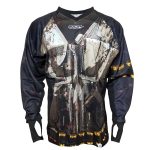 So you’ve decided to play paintball. Well, maybe not you. Maybe it’s your buddy’s bachelor party, maybe it’s your child’s birthday, or maybe it’s a company outing and your new boss is forcing the entire department to play against the wishes of HR. Either way, for whatever reason, the decision has been made, the date has been set and the call to the field has been made reserving your afternoon of paint covered bliss. As you ponder what a day at the paintball field will be like, the most pressing question you probably have is an age old one: Does Paintball hurt?
So you’ve decided to play paintball. Well, maybe not you. Maybe it’s your buddy’s bachelor party, maybe it’s your child’s birthday, or maybe it’s a company outing and your new boss is forcing the entire department to play against the wishes of HR. Either way, for whatever reason, the decision has been made, the date has been set and the call to the field has been made reserving your afternoon of paint covered bliss. As you ponder what a day at the paintball field will be like, the most pressing question you probably have is an age old one: Does Paintball hurt?
The short answer: Yes, but no.
Yes, paintballs are small gelatin capsules filled with paint, flying at around 285 feet per second, or around 200 miles per hour. When something this size (.68 caliber) gets moving that quickly, it’s bound to sting a little. However, many players – especially first time players – report that they don’t even feel the first shot because of the adrenaline. Even more report that after the shock of the first paintball is over, only pride can be hurt. Not convinced? Here’s a few steps you can take to ensure that sting is even less.

- Buy high quality paintballs. High quality paintballs are made to be brittle. They break more easily than lower grade paintballs, and a paintball that breaks easily is infinitely better than one that bounces. Social Paintball offers four grades of high quality paintballs, all of which are designed to break easily, and provide our players with a good “splat mark” to make sure your opponent knows they’ve been tagged.
- Layer up! Depending on your climate, layering is an essential way to reduce the sting of a paintball. We recommend two layers, consisting of an undershirt, and a long sleeve. This can be supported by a hoodie if necessary, but remember that bulky items can cause paintballs to bounce (regardless of their quality), which often hurt more than one that breaks. The best option though, is a paintball specific jersey and pants. Many jerseys, including our very own, come with padding in strategic areas to reduce the risk of injury. Additionally, a little head protection such as our headbands and headwraps can go a long way in helping you feel protected.
- Seek out a protective layer. Most fields will have some extra layer of protective gear for timid, or young players. These can be a great option if you bruise easily, are especially nervous, or have a previous injury that needs to be protected. Social Paintball offers a full selection of protective gear, from knee and arm pads to protect your joints from the ground, to an extra-padded sports bra to provide chest protection, and padded shorts which provide ample protection to the groin and hips.
- Cover the fingers! Shots to the hand happen more regularly than you might expect, but a garden glove or similar will provide adequate protection. If you’re looking for something with a little more flexibility and protection, our paintball specific glove is perfect for first time, and experienced players alike.
- Inquire about .50 caliber play. Today, many fields offer .50 caliber play, which is best suited for young children. .50 caliber paintballs are significantly smaller than the traditional .68 caliber paintballs. That smaller size equates to a paintball hit which can hardly be felt, and might be the right option for your party.
Does paintball hurt? No, not really! However, heat exhaustion and twisted ankles are the most common paintball related injuries. With that in mind, the most important tips we have are: keep hydrated and wear appropriate footwear! We are positive that if you follow our guidelines, you’ll go home with only a few bruises to your ego, and not your body.


